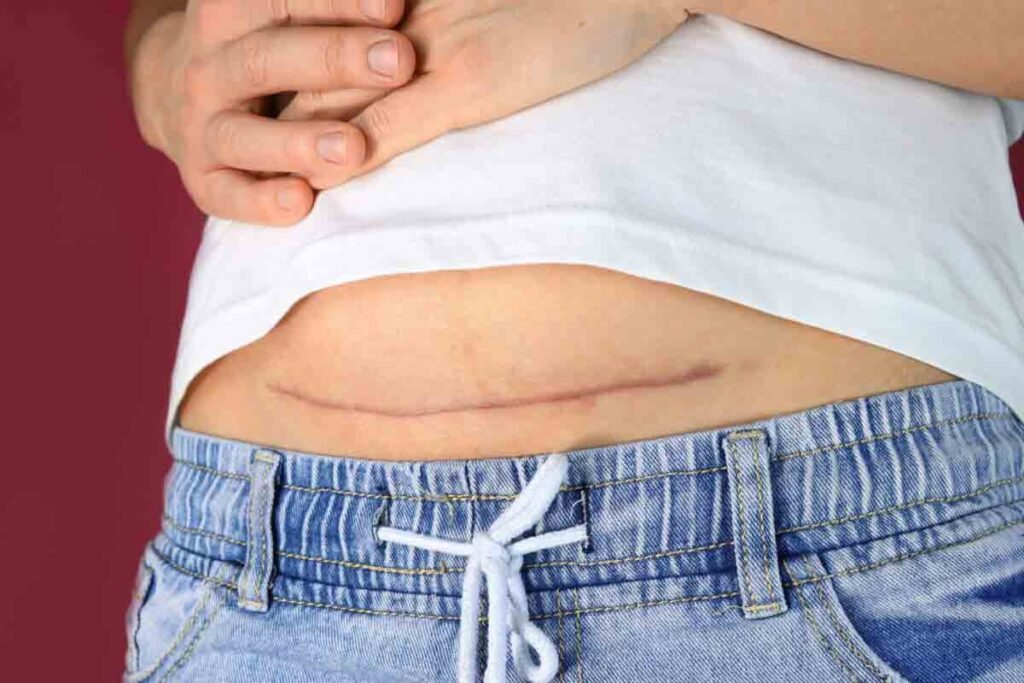
Abdominal adhesions are bands of scar tissue that form in the belly. They often happen after surgery and can cause a lot of problems. These include chronic pain, bowel obstruction, and infertility in women.
Liv Hospital is dedicated to treating abdominal adhesions. It’s important to know why and how these adhesions affect us. This knowledge helps in managing them and improving our quality of life.

Abdominal adhesions are bands of fibrous tissue that form between organs or the abdominal wall. They can cause chronic pain and bowel obstruction. This is a common problem after surgery.
These adhesions form when the body heals after surgery, infection, trauma, or radiation. Scar tissue binds organs or tissues together. This can make them malfunction or get obstructed.
Adhesions often occur in the lower abdomen and pelvis. Their location affects symptoms and complications.
| Location | Common Symptoms | Potential Complications |
| Lower Abdomen | Chronic pain, bloating | Bowel obstruction |
| Pelvis | Pelvic pain, infertility issues | Adhesive disease |
Knowing where adhesions form and their effects is key to managing and treating them.

It’s important to know why abdominal adhesions happen. They often form as a body’s response to injury or surgery. This leads to the growth of scar tissue.
Surgery is a big reason for abdominal adhesions, mainly in the West. Prior abdominal surgery is often the cause. When surgery damages the peritoneum, the lining of the belly, adhesions form as it heals.
The type of surgery, like laparoscopic or open, affects how likely adhesions are to form.
Inflammatory conditions in the belly can also cause adhesions. For example, diverticulitis and inflammatory bowel disease (IBD), including Crohn’s disease and ulcerative colitis, lead to chronic inflammation. This inflammation makes the body try to isolate the affected areas, forming adhesions.
Infections, like pelvic inflammatory disease (PID), can also cause adhesions. Other factors, such as trauma to the abdomen, can lead to adhesions too. Knowing these causes helps doctors diagnose and treat adhesions better.
It’s important to know the signs of abdominal adhesions to get help quickly. These adhesions can cause different symptoms that affect how you live your day.
Abdominal adhesions often cause chronic pain in the belly or pelvis. The pain can feel like a dull ache or a sharp stab. It might stay the same or get worse with movement.
Pain patterns with abdominal adhesions can differ:
Abdominal adhesions can also lead to digestive and bowel issues. These include:
In severe cases, adhesions can block the bowel, a serious issue that needs quick medical help.
Knowing when symptoms are a medical emergency is key. Signs of bowel obstruction, like severe pain, vomiting, and trouble passing gas or stool, need immediate care.
“Prompt recognition of severe symptoms can significantly improve outcomes in patients with abdominal adhesions.” – Medical Expert
| Symptom | Description | Severity |
| Chronic Pain | Dull ache or sharp pain in the abdomen or pelvis | Mild to Severe |
| Nausea and Vomiting | Feeling queasy or vomiting, potentially leading to dehydration | Mild to Severe |
| Bloating and Distension | Abdominal swelling due to gas or fluid accumulation | Mild to Severe |
| Bowel Obstruction | Severe pain, vomiting, and inability to pass gas or stool | Severe/Emergency |
Intestinal adhesions can lead to serious health problems. They can cause mild discomfort or life-threatening conditions. It’s important to understand the risks.
Intestinal adhesions often cause bowel obstruction. This blockage can lead to severe pain, vomiting, and constipation. If not treated, it can cause tissue death and intestine perforation.
A study in the Journal of Surgical Research found that adhesions cause up to 75% of small bowel obstructions. The risk is highest in the first few years after surgery.
Adhesive disease involves extensive adhesions in the abdomen. It can cause chronic pain, bowel dysfunction, and other symptoms. These symptoms can greatly reduce a patient’s quality of life.
Diagnosing and treating adhesive disease can be hard. It often requires a team effort from surgeons, gastroenterologists, and pain management specialists.
| Symptoms | Characteristics | Impact on Quality of Life |
| Chronic abdominal pain | Persistent and often severe | Significant reduction in daily activities |
| Bowel dysfunction | Constipation, diarrhea, or bowel obstruction | Emotional distress and social isolation |
| Infertility issues | Adhesions can affect reproductive organs | Psychological impact on individuals and couples |
Intestinal adhesions can have long-term effects. Chronic pain and bowel dysfunction can lead to malnutrition, fatigue, and depression. The emotional impact should not be ignored.
Patients with intestinal adhesions need to work closely with their healthcare providers. This may involve medical, surgical, and lifestyle changes.
Early diagnosis and treatment are key to managing intestinal adhesions. Understanding the risks helps patients and healthcare providers take steps to improve health outcomes.
Diagnosing abdominal adhesions is tough because their symptoms are not clear, and current imaging has limits. A detailed diagnostic plan is key to spotting adhesions and planning treatment.
Several imaging methods are used to find abdominal adhesions, including:
Though these methods are helpful, they might not always confirm a diagnosis. This is true when adhesions are small or hard to see.
Exploratory surgery is often needed to confirm abdominal adhesions. This can be done through:
These procedures help diagnose adhesions and can also treat them right away in some cases.
By using imaging and exploratory surgery together, doctors can fully understand a patient’s situation. They can then create a treatment plan that fits the patient’s needs.
Managing abdominal adhesions without surgery is possible. These methods help reduce symptoms and improve life quality for patients.
Medicines are key in managing pain from abdominal adhesions. Pregabalin is effective for chronic pain. Other options include pain relievers and anti-inflammatory drugs.
Changing your diet can help with abdominal adhesion symptoms. Eating a balanced diet with fiber helps with bowel movements and discomfort. It’s good to avoid foods that cause gas or bloating.
Using these non-surgical strategies, patients can find relief from abdominal adhesion symptoms.
Managing abdominal adhesions often involves a team effort. Physical therapy is a big part of this. It helps ease symptoms and improves life quality for those affected.
Physical therapists use manual soft tissue mobilization to reduce tension in the abdominal area. This method involves gentle, sustained pressure. It helps release adhesions and promotes normal tissue movement.
By using these techniques, therapists can help improve abdominal mobility. They also reduce pain caused by adhesions.
Physical therapists also create exercise programs for each person. These programs aim to enhance core strength, improve flexibility, and boost overall abdominal health. Regular exercise can stop new adhesions from forming and lessen the impact of existing ones.
Good exercises include gentle stretching, core stabilization, and activities that strengthen the pelvic floor. A well-planned exercise program is key to managing abdominal adhesions.
When other treatments don’t work, surgery is needed to remove adhesions. Surgical adhesiolysis is a method to help with symptoms caused by these adhesions.
Laparoscopic adhesiolysis is a minimally invasive surgery. It uses small incisions for a laparoscope and tools. This method has less recovery time and less pain than open surgery.
Open surgery is needed for some adhesion removals. It involves a bigger incision to directly access the abdomen. Open surgery risks more adhesion formation and longer recovery times, but is used for severe cases.
Choosing open surgery depends on the adhesion’s severity whether laparoscopic surgery is possible. Surgeons consider the patient’s health and adhesion extent.
A big risk of surgical adhesiolysis is further adhesion formation. Adhesions can come back, sometimes worse. Surgeons use anti-adhesion barriers and careful tissue handling to reduce this risk.
In summary, surgery is a good option for severe adhesion symptoms. Knowing the benefits and risks helps make better choices.
Knowing the exact type and location of abdominal adhesions is key to finding the right treatment. These adhesions can form in different places, like the stomach, colon, and small intestine. Each needs a special approach.
Scar tissue in the stomach and colon can cause big problems. These include bowel obstruction and chronic pain. To treat these adhesions, doctors often use a mix of medicine and surgery.
Omental and small intestine adhesions can lead to a lot of pain and bowel obstruction. The goal of treatment is to ease symptoms and stop more problems from happening.
Always talk to a healthcare expert to figure out the best treatment for your specific adhesions.
Proper care after adhesion treatment is key to a good recovery. The treatment’s success depends on following a recovery plan well.
Recovery after treatment includes several important steps. These are:
Effective pain management is very important at first. Patients might get pain meds or try acupuncture.
The time it takes to recover varies. It depends on the treatment and the person. Here are some general recovery milestones:
| Recovery Stage | Timeline | Expectations |
| Immediate Recovery | 1-2 weeks | Rest, pain management, and initial healing |
| Short-term Recovery | 2-6 weeks | Slowly getting back to normal, check-ups |
| Long-term Recovery | 6 weeks-3 months | Full recovery, back to hard activities, complete healing |
Patients need to stick to their recovery plan. They should also go to all follow-up appointments for the best results.
It’s important to prevent abdominal adhesions from coming back. A good plan includes surgery and changes in lifestyle. These steps can lower the chance of adhesions happening again.
Surgery is key in stopping adhesions from forming. Minimally invasive surgery causes less damage and heals faster. This means fewer adhesions. Also, barrier agents used in surgery keep tissues apart while they heal.
Here’s a table showing how surgery can help avoid adhesions:
| Surgical Technique | Benefits |
| Minimally Invasive Surgery | Reduces tissue trauma, promotes faster healing |
| Use of Barrier Agents | Separates tissues during healing, prevents adhesions |
| Gentle Tissue Handling | Minimizes tissue damage, reduces adhesion risk |
Changing your lifestyle is also vital. Dietary changes can help manage symptoms and lower adhesion risk. Eating foods high in fiber and antioxidants helps your digestive system and reduces inflammation.
Stress management is another key part. Stress can make symptoms worse and might even cause adhesions. Activities like meditation, yoga, and deep breathing can help keep stress down.
Here are some lifestyle changes to consider:
By using surgery and these lifestyle changes, people can greatly lower the chance of adhesions coming back. This improves their quality a lot.
Managing abdominal adhesions well needs a full plan that covers prevention, finding, and treatment. These adhesions cause a lot of health problems. Knowing what causes them, their signs, and issues is key to better care.
There are many ways to handle abdominal adhesions, from not using surgery to physical therapy and surgery. Using different methods helps lower the chance of problems and makes life better for those affected.
More research and learning are vital for better handling of abdominal adhesions. Keeping current with new methods and practices helps doctors give the best care. This way, they can lessen the risk of complications from adhesions.
Abdominal adhesions are bands of fibrous tissue. They can form between organs or between organs and the abdominal wall. This often happens after surgery, due to inflammation or infections.
Symptoms include chronic pain and digestive issues. Signs of bowel obstruction are also common. These include severe abdominal pain, vomiting, and constipation.
Doctors use imaging, like ultrasound or CT scans. They also do exploratory procedures like laparoscopy to diagnose.
Adhesions can cause bowel obstruction and adhesive disease. They can also have long-term health impacts. So, managing them properly is key.
Non-surgical methods include pain medication and dietary changes. These can help alleviate symptoms.
Physical therapy uses techniques like manual soft tissue mobilization. It also includes exercise programs. These can help reduce adhesions and improve abdominal health.
Surgical options include laparoscopic adhesiolysis and open surgery. Each has its benefits and risks. There’s also the chance of further adhesion formation.
To prevent recurrence, use surgical techniques that minimize adhesion formation. Lifestyle modifications are also important for long-term management.
After treatment, it’s important to follow post-treatment care strategies. Understanding the recovery timeline is also key to a successful outcome.
Yes, abdominal adhesions can affect the reproductive organs. This can lead to infertility in females.
Omental adhesions involve the omentum, a layer of tissue in the abdomen. Treatment approaches are tailored to the individual patient’s needs.
Adhesions can cause the intestines to stick together. This can lead to bowel obstruction and other complications.
Symptoms include pain, digestive issues, and signs of bowel obstruction. This depends on the location and extent of the scar tissue.
Yes, dietary modifications can help alleviate symptoms. They can improve the quality of life for individuals with abdominal adhesions.
Subscribe to our e-newsletter to stay informed about the latest innovations in the world of health and exclusive offers!
WhatsApp us